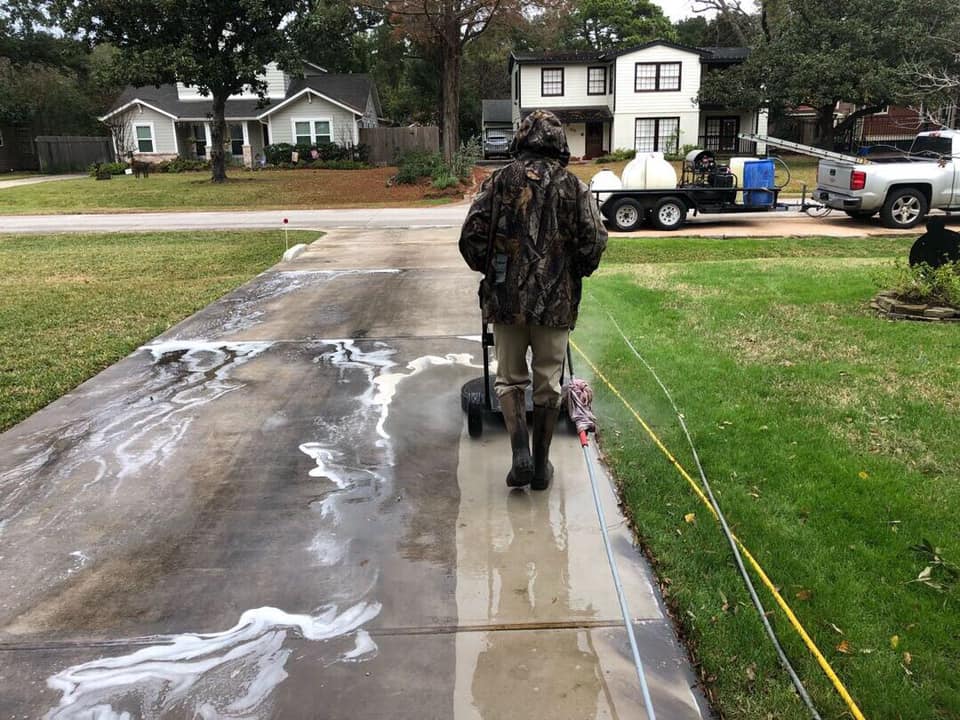Pressure washing your sidewalks can be a daunting task, but with the right preparation and knowledge it can be handled with ease. To tackle this project like a pro and achieve best results, there are several steps to take into consideration.
It is possible to transform your walkway from faded and weather-beaten to looking brand new again. The process of pressure washing requires patience and attention to detail in order to ensure that it is done correctly – like a master craftsman perfecting their craft.
This article will provide tips for successfully pressure washing your sidewalks so that you can get the job done right the first time around.
Gather the Right Tools
Having access to the right tools for pressure washing sidewalks can greatly improve the results of your task. For many people, it is a wise move to rent the necessary equipment rather than buy it outright. This can help ensure that you have access to the latest and most reliable models that are designed with safety measures in mind.
Depending on your area, there may be several options available when it comes to renting pressure washers and other equipment for this type of job. Researching all your local stores and online rental services helps ensure you get what you need at a competitive price.
When selecting the appropriate pressure washer for sidewalk cleaning, choosing one with adjustable PSI levels is essential. This allows you to customize the power level depending on how dirty or stained the surface is, which can help prevent damage from too much force being used on delicate surfaces or materials. Make sure all safety protocols are followed when using a pressure washer on any surface, including wearing protective eyewear and clothing as well as ensuring proper footing before turning on the machine.
It’s important to understand that while effective cleaning can often be achieved quickly with a pressure washer, there will usually still be some manual scrubbing required afterwards in order to remove stubborn dirt or stains. Furthermore, if mildew or mold has set into the surface then additional steps such as applying bleach may also be necessary prior to washing away any residue with water from a hose or pressure washer nozzle attachment.
Prepare the Area
Prior to pressure washing, it is important to prepare the area. This includes gathering the necessary materials and wearing appropriate clothing.
For materials, one may need a pressure washer, soap or detergent, a brush or broom for scrubbing areas that are particularly dirty and/or stubborn stains, goggles or safety glasses for eye protection from flying debris, gloves to protect hands from harsh chemicals, an extension cord if needed (for electric washers), and a ladder if working with high surfaces.
Proper attire should also be considered when preparing the area; this includes long pants, closed-toe shoes with non-slip soles, and protective eyewear.
Next steps include assessing the area where pressure washing will take place – such as identifying any cracks in sidewalks that may become larger due to water expansion – and making sure all nearby electrical outlets are properly sealed off before beginning the job.
It is also important to remove any outdoor furniture or other items that could potentially be damaged by water force or cleaning products being used.
Once everything has been prepared beforehand according to safety protocols and guidelines set forth by local authorities related to pressure washing activities, it is then time to begin the job itself: starting with setting up the pressure washer correctly in accordance with manufacturer instructions; following proper rinsing techniques; using safe amounts of cleaning solution; etc.
Create a Cleaning Plan
Before pressure washing can commence, a comprehensive cleaning plan should be formulated in order to ensure the most successful outcomes with minimal effort and maximum hilarity.
A pre-inspection of the area is essential for two reasons: firstly, it allows any potential safety hazards to be identified and addressed; secondly, it helps to determine what type of materials are present that may require specific cleaning agents or techniques. This assessment will also provide an indication of how long the pressure washing process may take.
The cleaning plan should include details such as:
– which areas need to be cleaned
– what type of detergent is required (if any)
– how much water pressure needs to be used
– whether there are any fragile objects nearby that could get damaged by flying debris
– what safety precautions should be taken before commencing work
It is important not only to consider the size and shape of the area being washed but also any particular substrates or surfaces which could react differently when exposed to high-pressure water jets.
Having established these parameters, a timeline for completion can then be set out so that all tasks are completed efficiently and with no surprises along the way.
When formulating a plan for pressure washing sidewalks, it is also important to bear in mind local regulations regarding discharge into stormwater drains – this will help avoid costly fines or potential legal action further down the line.
Apply Detergent and Pressure Wash
Once the cleaning plan has been established, detergent must be applied and the area pressure washed to ensure effective removal of dirt and debris. To begin, it is important to choose a detergent that is suitable for the job. A mild detergent should be chosen if the surface being cleaned does not have any heavy stains or grease. However, a stronger detergent should be used for heavily soiled surfaces such as driveways and sidewalks with oil spots or other stubborn stains.
When applying the detergent, it is important to first apply water at low pressure to wet the surface before adding any chemicals. This will help reduce damage that could potentially occur due to too much pressure in combination with harsh chemicals. After this step, add an adequate amount of detergent according to label instructions and then wait several minutes before starting pressure washing. During this time, allow the chemical reaction between water and detergent take place so that they can break up dirt particles on the surface more effectively.
It is also important to use a pressure washer at an appropriate flow rate and pressure gauge setting for each particular job in order to avoid damaging fragile materials like wood or brickwork while still achieving optimal results from cleaning with minimal effort. Generally speaking, lower pressure settings are better suited for softer surfaces such as wood decks while higher pressures are best used on harder surfaces such as concrete patios or asphalt driveways.
| Pressure Gauge | Flow Rate |
| ————– | ———-|
| Low | Soft Surfaces (wood decks) |
| High | Hard Surfaces (concrete patios/asphalt driveways) |
Rinse and Allow to Dry
Finally, it is necessary to complete the cleaning procedure by implementing safety measures and rinsing off all detergent residue. This can be done with a pressure washer that is fitted with an adjustable nozzle and appropriate psi rating for the surface being cleaned. For best results, choose equipment that meets the requirements of the job without over-saturating or causing damage to the area.
After washing, allow adequate time for rainfall or a garden hose to completely rinse away any remaining suds or debris from the sidewalk’s surface.
The final step in pressure washing sidewalks is allowing them to dry completely before use. The drying process depends upon several factors such as air temperature, humidity level, direct sunlight exposure, and wind strength. To avoid damaging effects of moisture seeping into cracks and crevices, it is important to let any freshly-cleaned surfaces dry thoroughly before people walk on them again. Also, since professional-grade detergents are not always biodegradable, it may take a few days for them to break down naturally after contact with water sources like rain or hosing down areas.
Ideally, homeowners should wait at least 24 hours after applying detergent and pressure washing their sidewalks before letting anyone traverse them again. Since preventative maintenance plays an important role in prolonging life expectancy of surfaces around the home, following these steps will ensure optimal results while avoiding potential risks associated with high-pressure cleaning techniques.
Conclusion
Effective pressure washing of sidewalks requires a combination of the right tools, proper preparation and an effective cleaning plan.
Following these steps will ensure that the surfaces are thoroughly cleaned with minimal disruption to surrounding areas.
The use of detergents and pressure washers should be employed in order to achieve optimal results.
Once completed, it is important to rinse off any remaining residue and allow the area to dry completely before use.
Pressure washing sidewalks can be an efficient way to keep outdoor spaces clean while preserving appearance and functionality.
With careful planning and attention to detail, sidewalks can be kept looking their best for years to come.




